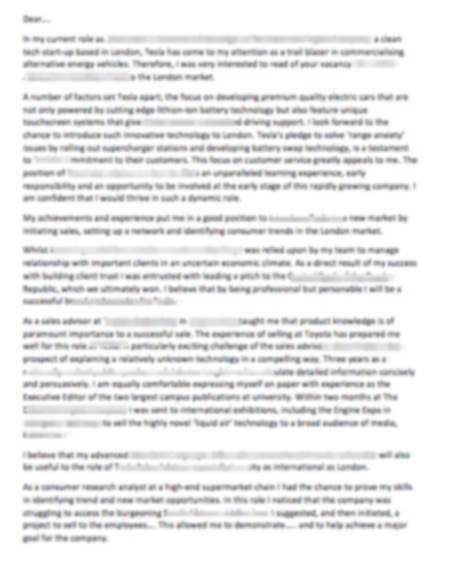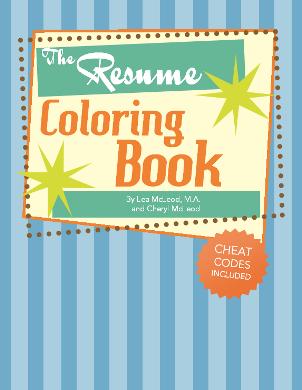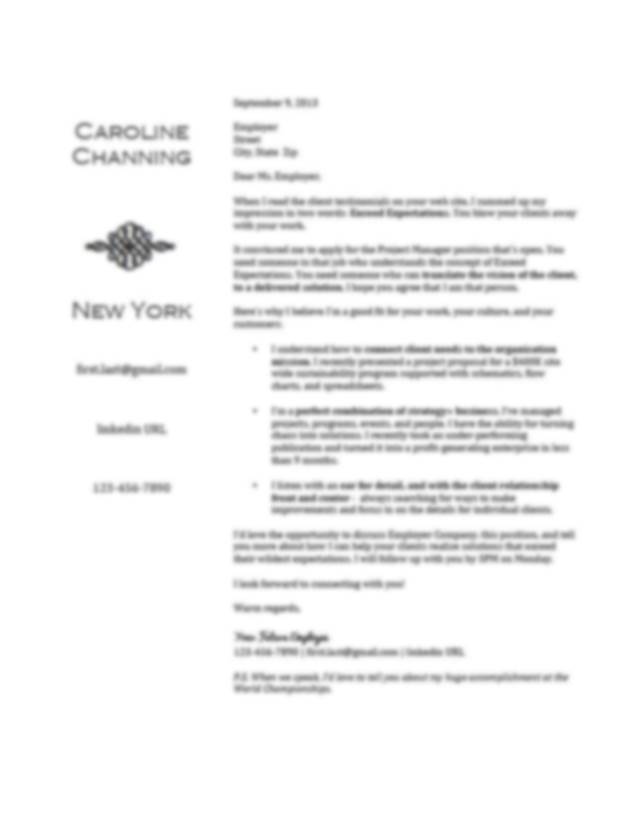Don’t write a sucky cover letter.
Use these 5 easy ways to make your cover letters better!
.
I read an article recently that said 95% of recruiters don’t read cover letters. It then went on to explain why.
One recruiter said cover letters were so unilaterally bad, he had concluded they weren’t worth reading, therefore he didn’t.
And I know we don’t like writing them because clients email me and say, “Well it doesn’t say a cover letter is required, so I must not need to send one, right?”
Wrong. You need to send one. Just make sure it doesn’t look like this:
 This is the draft a client recently sent me of one she was planning to use. It’s one of the reasons 95% of recruiters don’t read cover letters.
This is the draft a client recently sent me of one she was planning to use. It’s one of the reasons 95% of recruiters don’t read cover letters.
I mean, really, if you were a hiring manager, how much time would you spend on this letter?
So I am an advocate for sending cover letters, whether they are requested or not. Some recruiters will read them. Some will not. You can’t control that.
What you CAN control is the quality, effort, and content you put into a letter that, coupled with a great resume will put you up 2-0 over the less prepared competition.
Here are 5 ways you can write a great cover letter, and get it read.
1. Keep the main thing, the main thing.
The purpose of the cover letter is not to tell your whole life story. Nor is its purpose to regurgitate everything on your resume. When you do either, you make your cover letter longer than it needs to be. Look, don’t over-engineer this. I see way too many cover letters that are multiple pages.
If you think you have to write multiple pages, you’re making it too hard.
They won’t get read.
Besides, you need to save something for the interview!
The cover letter should be an invitation to look further at you, and create a compelling reason for a reader to grab your resume (and hopefully be mesmerized by it).
Your goal is to:
- Introduce yourself.
- Tell the narrative about how your experience makes you the perfect candidate for a job.
- Create a call to action for following up.
To that end it should be inviting to read, create a connection to the employer, and be no more than one page!
2. Make it inviting to read.
Remember that any given recruiter is looking at gobs of cover letters, and probably sifting through a couple of hundred emails per day.
Any document you send relative to a job search, is competing with hundreds of others documents for ‘eyeball time.’
To wit, 83% of recruiters recently said they spend one minute, or less, reading a cover letter.
That means they are skimming, not reading.
That means the example I showed you at the beginning is not going to tell a recruiter much at all. It’s impossible to skim. Most likely it will go in the discard pile.
So, your job is to give them meaningful, easy-to-digest-in-one-minute information.
That means:
- A simple opening paragraph that connects to them.
- Bullets of compelling evidence that position you as the perfect candidate
- A closing paragraph with a call to action.
- Strategically placed bold font to lead the viewer down the page.
- Lots of white space.
- Absolutely, positively no more than one page.
Compare this “look” of the example below to the one I showed you at the beginning.
.
Readable in one minute? Check.
.
Visually interesting? Check.
.
More likely to get read than the one at the top? Totally.
.
3. Unify your design.
.
Make your cover letter look and feel like your resume and other marketing material. This presents you as having thought through all your materials.
.
Some might call this branding.
.
Others might call it planning.
.
I like to think of it as being professional.
.
And it doesn’t have to be fancy. If you use horizontal lines at the top of your resume, convey that same look to your cover letter. Make them feel like a “matched correspondence set.”
.
 If you want a proven template for your resume and cover letter materials, you need The Resume Coloring Book online course.
If you want a proven template for your resume and cover letter materials, you need The Resume Coloring Book online course.
.
It walks you through step-by-step how to create your cover letter and resume, and is proven to get you more interviews. Check it out here.
.
.
4. Invite the reader in with a good introduction.
.
Please do not start a cover letter with: “I’m writing to apply for such and such position, # 123455.” Gah!
.
That’s how all the OTHER letters start. And you want to STAND OUT from them.
.
Instead, in that first paragraph make a connection of some kind to the employer. It can be anything from the mention of mutual acquaintances, an experience you had with the organization or industry, or maybe something you found on the employer’s web site that you can comment on.
.
I find this is often a sticking point for new grads. It can be challenging to finesse those initial sentences that connect you to an employer, in a way that makes them want to keep reading. What should you say other than, “I’m here to apply for….”? Do some research. Make it authentic and interesting.
.
Here is an example:
.
When I read the client testimonials on your web site, I summed up my impression in two words: Trusting Relationships. You blow your clients away with your commitment to their goals. It convinced me to apply for the Project Manager position that’s open.
.
You need someone in that job who understands the concept of Trusting Relationships. You need someone who can translate the vision of the client, to a delivered solution. I hope you agree that I am that person.
.
5. Provide your evidence.
.
Think of your cover letter as the “highlights” and the resume as the “detail” of why you are the perfect candidate. In your cover letter body, use 3 or 4 bullets to share evidence and accomplishments that position you as qualified.
.
- Be brief, articulate and to the point.
- Quantify the scope of work and results.
- Bold the keywords the employer is looking for in that job.
.
Here’s an example:
.
I understand how to connect client needs to the organization mission. I recently presented a project proposal for a $400K site wide sustainability program supported with schematics, flow charts, and spreadsheets.
.
I’m a perfect combination of strategy+ business. I’ve managed projects, programs, events, and people. I have the ability for turning chaos into solutions. I recently took an under-performing publication with a circulation of over 25,000 and generated a $750,000 profit in less than 9 months.
.
I listen with an ear for detail, and with the client relationship front and center – I’ve worked with up to 30 unique clients while sustaining nearly 100% client satisfaction in my programs.
.
Tie the examples and results to the desired skill set for the job.
.
Bonus:
End your letter with a call to action about when you will call the employer. For that to work, however, you must follow up on your commitment and call them. If you don’t, you’ve lost credibility in the search. As well, a P.S. might not be a bad idea, as P.S. memos on letters always get read. You can include a teaser about a great story you have, a big accomplishment, or a testimonial from a reference.
.
Ok, there you have it. You now have no excuse for writing a cover letter that sucks. In addition, I know these steps will help you feel more confident about putting your best (written) foot forward.
.
.
.
.


When is cover letter necessary? Should we use it along with resume or there is something like only some particular job post need it. I want an answer. I didn’t prepare it. I prepared my resume through <a href=”http://www.osamresume.com/”>best resume writing service</a> and it looks great. Should I attach a cover letter too when applying for a job.